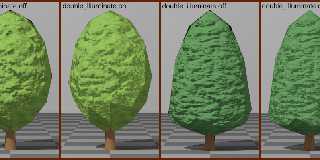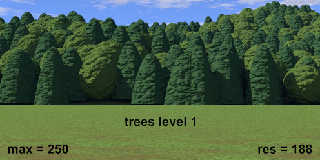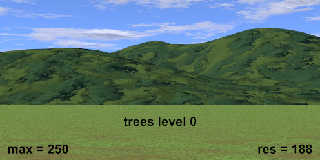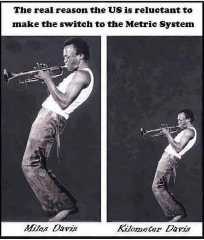 |
 |
|
 |
|
 |
|  |
|  |
|
 |
|
 |
|  |
|  |
|
 |
Tradeoffs, tradeoffs, tradeoffs.
First some background, which I vainly imagine would be interesting to
people other than myself. I started writing a prefab render rig a
couple days after I downloaded POV-Ray in 2003, and I've been obsessed
with tweaking successive rigs ever since. My first try included an
infinite checkered plane with outdoorsy lighting. Why outdoors?
Because I like the visual effect of the warm direct lighting and cool
shadows.
It didn't take long before I was struggling with moiré artifacts. In my
first reboot, I simply gave up on the checkered plane. My second reboot
in 2004 had two modes: an outdoor mode with a grassy bozo pattern that
is not prone to distracting artifacts; and an indoor mode with a finite
checkered floor. (I absolutely had to keep a checkered plane in some
form, as I was still carefully considering my first p.b.i post. I was
planning to post a workaround for the Fresnel/dispersion bug using a
reflective glass sphere, but then the dev team fixed that bug in v3.6,
leaving me at a loss for ideas. I think my first p.b.i post was "RSOCP
overkill.")
There the grassy plain remained for the next few years, with little more
than the occasional surface normal tweak. Then for Thanksgiving 2007, I
was invited to my brother's girlfriend's family's place in the
Shenandoah Mountains, and I knew I had to have some hills for my render
rig. (Funny how the hills in my native Virgin Islands never inspired me
that way. New Yorkers don't visit the Statue of Liberty either.) I
just threw up a layered pigment onto my sky_sphere, and was done for the
next few years.
Over the years, the code grew increasingly disorganized, and I was
becoming concerned about namespace issues, so in 2012, I decided it was
time for another reboot. This time I used a height field for the hills
instead of a sky_sphere pigment. At first I just used a bumpy texture
to simulate a forest, but 3 years ago I made the fool decision to
include actual tree objects. Since finished art products are strictly
off-label for this project, the tree models could be very rudimentary.
Spheres and simple CSG forms would do.
As it turns out, forests are extremely memory intensive, so now I'm
looking at mesh trees to see if they will save memory over CSG objects,
with a bonus of looking more realistic. But before I can do the memory
test, I must have a tree model. POV-Tree? TomTree? Bah, PERL, Java,
and real life in too much disarray to tolerate the learning curve. OK,
I'll just roll my own /slightly/ more realistic trees.
An isosurface forest is another option, which vanquishes memory
concerns, but I haven't yet come up with a function that I'm satisfied with.
TL;DR: I'm now working on very low detail mesh trees.
I found the black borders on the smooth triangles unexpectedly
disturbing. They do show up on my height field hills under some
circumstances, but are quite tolerable. But seeing them cap my trees
sent me straight to double_illuminate. Disappointingly, double
illumination had its own peculiarities near the shadow lines. And when
I added surface normals to the trees, it got really weird. As you can
see, with double illumination the facet edges at the shadow lines are
far more noticeable, the shadow contrast is weaker on the normal
pattern, and the lit areas near the shadow lines are just surreal.
Tradeoffs. I'm looking to skip the double illumination and tolerate the
black borders.
P.S. These images use the indoor setting of the 4th prefab render rig.
Post a reply to this message
Attachments:
Download 'make_sotd_tree_meshes-pbi.jpg' (105 KB)
Preview of image 'make_sotd_tree_meshes-pbi.jpg'

|
 |
|  |
|  |
|
 |
|
 |
|  |
|  |
|
 |
On 2-8-2018 1:33, Cousin Ricky wrote:
> Tradeoffs, tradeoffs, tradeoffs.
>
> [snip]
> Tradeoffs. I'm looking to skip the double illumination and tolerate the
> black borders.
>
> P.S. These images use the indoor setting of the 4th prefab render rig.
A bell is tolling in the back of my mind but I am unable to find it in
the mental mist, yet.
Without too much memory load increase you could increase the mesh
resolution. Between 2 and four times should do the trick.
Your mention of an isosurface forest could be horribly slow to render.
Gilles Tran used isosurface trees in some of his scenes but you
certainly know that.
--
Thomas
Post a reply to this message
|
 |
|  |
|  |
|
 |
|
 |
|  |
|  |
|
 |
Cousin Ricky <ric### [at] yahoo com> wrote:
>
> TL;DR: I'm now working on very low detail mesh trees.
> I found the black borders on the smooth triangles unexpectedly
> disturbing... Disappointingly, double
> illumination had its own peculiarities near the shadow lines.
>
> Tradeoffs. I'm looking to skip the double illumination and tolerate the
> black borders.
>
IMO, the trees with double_illuminate ON look (tolerably) better than with it
off. The trees appear to blend in better with your background sky pigment. From
a practical viewpoint, I think the non-smooth 'appearance' of the outside tree
borders (the straight triangle edges) would be more noticable to someone's eyes
than the double_illumination artifacts. Ditto the triangle edges within the body
of the tree. Since the trees are *designed* to be very low-memory-intensive (and
will not the 'central focus' of any render that you use them in), they look
quite decent. (Although, I would suggest upping the triangle count just a
little, to make them a bit smoother overall-- which, I admit, might erase the
nice 'angular' effect of the outside tree edges!)
Another *possible* way around the problem would be to use an interior texture as
well-- maybe with the color of the sky (or the tree itself?), and a high ambient
or emission value for its finish. Then those edge normals might 'pick up' that
interior color rather than, say, black. Just a theory.
And a gentle reminder: #declaring the tree meshes themselves beforehand will
allow almost unlimited copies with very little memory increase.
As for the double_illuminate artifacts at the edges of the trees: Does the
width/size of those rendered artifacts diminish if the trees are placed far into
the distance? Or does the width remain constant (i.e., possibly becoming as
large as an entire distant tree?) In other words, are the artifacts independent
of camera-tree distance? I don't think I've ever tried such an experiment to
see. com> wrote:
>
> TL;DR: I'm now working on very low detail mesh trees.
> I found the black borders on the smooth triangles unexpectedly
> disturbing... Disappointingly, double
> illumination had its own peculiarities near the shadow lines.
>
> Tradeoffs. I'm looking to skip the double illumination and tolerate the
> black borders.
>
IMO, the trees with double_illuminate ON look (tolerably) better than with it
off. The trees appear to blend in better with your background sky pigment. From
a practical viewpoint, I think the non-smooth 'appearance' of the outside tree
borders (the straight triangle edges) would be more noticable to someone's eyes
than the double_illumination artifacts. Ditto the triangle edges within the body
of the tree. Since the trees are *designed* to be very low-memory-intensive (and
will not the 'central focus' of any render that you use them in), they look
quite decent. (Although, I would suggest upping the triangle count just a
little, to make them a bit smoother overall-- which, I admit, might erase the
nice 'angular' effect of the outside tree edges!)
Another *possible* way around the problem would be to use an interior texture as
well-- maybe with the color of the sky (or the tree itself?), and a high ambient
or emission value for its finish. Then those edge normals might 'pick up' that
interior color rather than, say, black. Just a theory.
And a gentle reminder: #declaring the tree meshes themselves beforehand will
allow almost unlimited copies with very little memory increase.
As for the double_illuminate artifacts at the edges of the trees: Does the
width/size of those rendered artifacts diminish if the trees are placed far into
the distance? Or does the width remain constant (i.e., possibly becoming as
large as an entire distant tree?) In other words, are the artifacts independent
of camera-tree distance? I don't think I've ever tried such an experiment to
see.
Post a reply to this message
|
 |
|  |
|  |
|
 |
|
 |
|  |
|  |
|
 |
Cousin Ricky <ric### [at] yahoo com> wrote:
>
> An isosurface forest is another option, which vanquishes memory
> concerns, but I haven't yet come up with a function that I'm satisfied with.
Have you considered using isosurfaces for *individual* tree models? I'm thinking
of maybe an egg-shaped function, plus some f_noise(...) to break up the surface.
I would imagine that maybe five to ten different tree models might suffice to
populate an entire (random) forest. And AFAIU currently, copies of the
isosurfaces *may* not take up much extra memory; Clipka mentioned this in a
recent thread (the last entry there)...
http://news.povray.org/povray.advanced-users/thread/%3C5b57c158%241%40news.povray.org%3E/
>
> As you can see, with double illumination [on]...the lit areas near the shadow
> lines [in the body of the tree] are just surreal.
>
I've noticed that too, when rendering low-resolution height_fields. It *does*
seem to be a tradeoff, between using smooth triangles vs. unsmooth, and
double_illuminate vs. no D_I. I've not been able to come up with a satisfactory
compromise. com> wrote:
>
> An isosurface forest is another option, which vanquishes memory
> concerns, but I haven't yet come up with a function that I'm satisfied with.
Have you considered using isosurfaces for *individual* tree models? I'm thinking
of maybe an egg-shaped function, plus some f_noise(...) to break up the surface.
I would imagine that maybe five to ten different tree models might suffice to
populate an entire (random) forest. And AFAIU currently, copies of the
isosurfaces *may* not take up much extra memory; Clipka mentioned this in a
recent thread (the last entry there)...
http://news.povray.org/povray.advanced-users/thread/%3C5b57c158%241%40news.povray.org%3E/
>
> As you can see, with double illumination [on]...the lit areas near the shadow
> lines [in the body of the tree] are just surreal.
>
I've noticed that too, when rendering low-resolution height_fields. It *does*
seem to be a tradeoff, between using smooth triangles vs. unsmooth, and
double_illuminate vs. no D_I. I've not been able to come up with a satisfactory
compromise.
Post a reply to this message
|
 |
|  |
|  |
|
 |
|
 |
|  |
|  |
|
 |
On 2018-08-02 03:10 PM (-4), Kenneth wrote:
>
> (Although, I would suggest upping the triangle count just a
> little, to make them a bit smoother overall-- which, I admit, might erase the
> nice 'angular' effect of the outside tree edges!)
More striking than the edge effect are the cast shadows. The smooth,
round shadows of the spheres I'm currently using are quite jarring when
cast on the other trees, especially against the texture normals. (See
the cast shadow near the right edge of show_sotd_hills_res-hf1-3.jpg.
The other image is of the height field at the same scale. In general,
though, the hills would be *much* farther away, with the details that
much less noticeable. The 'max' figure is the scaling of the noise
function in feet[1], but my default is 5000.)
> And a gentle reminder: #declaring the tree meshes themselves beforehand will
> allow almost unlimited copies with very little memory increase.
That's exactly what I had in mind.
> As for the double_illuminate artifacts at the edges of the trees: Does the
> width/size of those rendered artifacts diminish if the trees are placed far into
> the distance? Or does the width remain constant (i.e., possibly becoming as
> large as an entire distant tree?) In other words, are the artifacts independent
> of camera-tree distance? I don't think I've ever tried such an experiment to
> see.
The artifacts are an effect of the fake normals on the triangles
themselves (search Smooth Triangle Artifact in the wiki), so they would
scale down with the tree distance.
_________________
[1] I did not choose my country of birth, but if I ever release the
source code, meters will be an option.
Post a reply to this message
Attachments:
Download 'show_sotd_hills_res-hf1-3.jpg' (53 KB)
Download 'show_sotd_hills_res-hf0-3.jpg' (43 KB)
Preview of image 'show_sotd_hills_res-hf1-3.jpg'

Preview of image 'show_sotd_hills_res-hf0-3.jpg'

|
 |
|  |
|  |
|
 |
|
 |
|  |
|  |
|
 |
On 2018-08-02 02:43 AM (-4), Thomas de Groot wrote:
>
> Your mention of an isosurface forest could be horribly slow to render.
So it is.
> Gilles Tran used isosurface trees in some of his scenes but you
> certainly know that.
I haven't examined how he did most of his scenes; although I am
impressed at how he managed to render a rainy scene in "The Wet Bird"
without rendering any rain.
Post a reply to this message
|
 |
|  |
|  |
|
 |
|
 |
|  |
|  |
|
 |
Cousin Ricky <ric### [at] yahoo com> wrote:
> [1] I did not choose my country of birth, but if I ever release the
> source code, meters will be an option.
Miles, baby. Miles. com> wrote:
> [1] I did not choose my country of birth, but if I ever release the
> source code, meters will be an option.
Miles, baby. Miles.
Post a reply to this message
Attachments:
Download '870608197461278720.jpg' (123 KB)
Preview of image '870608197461278720.jpg'

|
 |
|  |
|  |
|
 |
|
 |
|  |
|  |
|
 |
On 02/08/2018 21:50, Bald Eagle wrote:
> Cousin Ricky <ric### [at] yahoo com> wrote:
>
>> [1] I did not choose my country of birth, but if I ever release the
>> source code, meters will be an option.
>
> Miles, baby. Miles.
>
:D
Ells baby, ells. :)
"Gie 'im an inch, an he'll tak an ell"
https://en.wikipedia.org/wiki/Ell#Ell_(Scots)
--
Regards
Stephen com> wrote:
>
>> [1] I did not choose my country of birth, but if I ever release the
>> source code, meters will be an option.
>
> Miles, baby. Miles.
>
:D
Ells baby, ells. :)
"Gie 'im an inch, an he'll tak an ell"
https://en.wikipedia.org/wiki/Ell#Ell_(Scots)
--
Regards
Stephen
Post a reply to this message
|
 |
|  |
|  |
|
 |
|
 |
|  |
|  |
|
 |
Stephen <mca### [at] aol com> wrote:
> Ells baby, ells. :)
>
> "Gie 'im an inch, an he'll tak an ell"
>
> https://en.wikipedia.org/wiki/Ell#Ell_(Scots)
Bloody Ell. That's interesting :) And I have learned something new.
Well done, Lord McAvoy, well done. com> wrote:
> Ells baby, ells. :)
>
> "Gie 'im an inch, an he'll tak an ell"
>
> https://en.wikipedia.org/wiki/Ell#Ell_(Scots)
Bloody Ell. That's interesting :) And I have learned something new.
Well done, Lord McAvoy, well done.
Post a reply to this message
|
 |
|  |
|  |
|
 |
|
 |
|  |
|  |
|
 |
On 02/08/2018 23:14, Bald Eagle wrote:
> Stephen <mca### [at] aol com> wrote:
>
>> Ells baby, ells. :)
>>
>> "Gie 'im an inch, an he'll tak an ell"
>>
>> https://en.wikipedia.org/wiki/Ell#Ell_(Scots)
>
>
> Bloody Ell. That's interesting :) And I have learned something new.
>
It makes an ell of a difference. ;)
> Well done, Lord McAvoy, well done.
>
>
>
No it was Tim Cook, of yore, who had the top hat and cane. I'm the one
brandishing the pitchfork and guiding the tumbrel. :)
--
Regards
Stephen com> wrote:
>
>> Ells baby, ells. :)
>>
>> "Gie 'im an inch, an he'll tak an ell"
>>
>> https://en.wikipedia.org/wiki/Ell#Ell_(Scots)
>
>
> Bloody Ell. That's interesting :) And I have learned something new.
>
It makes an ell of a difference. ;)
> Well done, Lord McAvoy, well done.
>
>
>
No it was Tim Cook, of yore, who had the top hat and cane. I'm the one
brandishing the pitchfork and guiding the tumbrel. :)
--
Regards
Stephen
Post a reply to this message
|
 |
|  |
|  |
|
 |
|
 |
|  |
|
 |




![]()